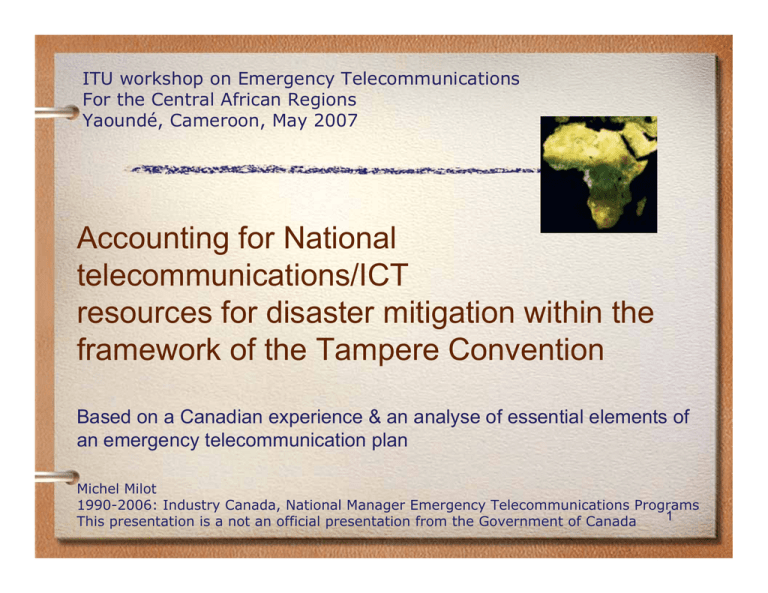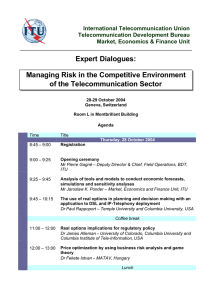ITU workshop on Emergency Telecommunications For the Central African Regions
advertisement

ITU workshop on Emergency Telecommunications For the Central African Regions Yaoundé, Cameroon, May 2007 Accounting for National telecommunications/ICT resources for disaster mitigation within the framework of the Tampere Convention Based on a Canadian experience & an analyse of essential elements of an emergency telecommunication plan Michel Milot 1990-2006: Industry Canada, National Manager Emergency Telecommunications Programs 1 This presentation is a not an official presentation from the Government of Canada Presentation Michel Milot Industry Canada Emergency Telecommunication Inventory Tampere Convention International Mutual Aid & Tampere Convention Examples - Use of Inventory in Past Emergencies 6 Questions - Telecom Related Conclusions 2 Michel Milot / background Radio Inspector Emergency “on site” Officer National Manager Emergency Telecommunication International Experience Canada/USA Asia OCHA and ITU NATO 3 Industry Canada : Lead role in telecommunications (1) In collaboration with federal and provincial governments and the telecommunication industry Develop, maintain and execute emergency telecommunication plans for: Radio Spectrum Management Advise and Assistance Federal departments Provincial departments Telecommunication providers 4 Industry Canada : Lead role in telecommunications (2) In collaboration with federal and provincial governments and the telecommunication industry: Develop, maintain and execute emergency telecommunication plans to: Coordinate the provision of a National Public Alerting Service Facilitates the provision and the movement of telecommunication equipments and services Manages programs to help ensure the availability of essential telecommunications during periods of system overload or degradation (Need an inventory) 5 Facilitates the provision of appropriate telecommunication equipment or services required in an emergency response operation In Canada: 80 to 90% of telecomm critical infrastructure is owned by the private industry Support provincial authorities for most emergencies No physical inventory or stock piles (“Just-in-time”) 6 Facilitates the provision of appropriate telecommunications equipments or services required in emergency response operations Partnership and public relation Close relations with federal and provincial PPDR organizations Close relations & agreements with the telecom industry Canada / United States Advisory Group Tampere convention Emergencies Act 7 Emergency Telecommunication Inventory in Canada Definition Why and how? Software & lessons learned Not a simple mechanism An on-going Public Relation’s task Stockpiles (not at the national level) Tampere Convention 8 Definitions and types of inventories Inventory of normal operational equipment is a PPDR responsibility National: Facilitate the provision of equipment and services if additional needs are requested for: Extraordinary operations (disasters or special events) Replace or re-engineer equipments or networks destroyed or degraded 9 Why and how ? Identify the needs What could go wrong Difficult to identify with precision Meeting telecommunication providers, suppliers and other governmental organizations “in advance” to: Discuss national needs Evaluate capabilities and agreement to participate Verbal Agreements, MOU, or LOU Committees on emergency telecommunications National telecommunication provider associations 10 Software & lessons learned Each situation is different: Canada - software in 1996 Became complex and difficult to manage During emergencies, old systems were used successfully Inventory integrated into BCP/BRP program 11 Inventory - not a simple mechanism -ongoing Public Relation’s task (1)Cannot be fed by names, address or phone numbers taken from the telephone directory Inventory is not a document to be completed and fill in the blanks and kept on the shelf Inventory is a trust relationship between government and private/public organizations who have the equipment and the expertises to help in times of an emergency 12 Inventory - not a simple mechanism - ongoing public relation task (2) In Canada, providers and suppliers are visited or contacted on a regular basis . During an emergency it is to late to make friends Industry Canada Chairs 10 Regional Emergency Telecomm Committees Chairs one national symposium (every two years) Industry Canada is an associate member of the Canadian Telecommunication Emergency Preparedness Association Financial agreements…. 13 Partnership & Inventories PPDRs at all levels are responsible for their physical inventory. If there is a need to increase the capability or build new networks (radio, telephone, wireless, satellite, etc,) - Partners are contacted Partners are involved in emergency telecommunication plan. No physical inventory or “stockpiles” at the national level: Needs could not be anticipated Maintenance and /or storage would cost too much Equipment could rapidly become obsolete 14 The Tampere Convention on the Provision of Telecommunication Resources for Disaster Mitigation and Relief Operations 15 Tampere Convention Article 8 on inventory Notification to the operational coordinator the name or organization of its authority(ies): a)Authorized to request, offer, accept and terminate telecommunication assistance; and b)Competent to identify the governmental, intergovernmental and/or non-governmental telecommunication resources 16 Tampere Convention Article 8 on inventory (In Canada) Industry Canada – Emergency Telecommunications is the point of contact. Department of Foreign Affairs has the legal responsibility for matters arising under the terms of this Convention In Canada, Industry Canada, Foreign Affairs and department of Public Safety would work closely together in the application of the Convention. 17 International mutual aid and Tampere Convention (Article 10) This Convention shall not affect the right and obligations of States Parties from other international agreements or international law. 18 International Mutual Aid and Tampere Convention United States and Canada The Civil Emergency Planning Telecommunications Advisory Group (CEPTAG) 19 Examples Ice storm Telephone poles down Telco put up poles and lines quickly assist hydro crews – sharing of the poles. GoC facilitated the supply of equipment GoC facilitate maintaining backup power supply (fuel - road) Radio frequencies for PPDR Priority access to telephone service Ontario blackout Wireless service networks overloaded Fuel access for Telcos /including 911 20 http://www.itworldcanada.com/a/Departmental-and-End-User-Computing/e5762987-3a16-451c-b79b-0c003b7ecb3e.html Study on Emergency Telecommunication • Nine nations accepted to share with us, elements of their emergency telecom plan and/or lessons learned from recent emergencies • The following questions are directly or indirectly related to telecom inventory 21 Question (1) Does your “Public Protection Disaster Relief (PPDR)” organizations have access to sufficient radio equipment and networks in times of a disaster? “Yes” at 70% 22 Question (2) Do you maintain an inventory of radio communication equipment for additional needs in time of disaster? Precise equipment inventory at national level: None Inventory of suppliers at national level (60%) Precise equipment inventory is a municipal or regional responsibility: (40%) Planned for the future (20%) No (50%) 23 Question (3) Do you have agreements with other governmental organizations or with the private sector to obtain equipment or services from this inventory? At national level: Yes (50%) PPDR at local/regional/national level (30%) No (30%) 24 Question (4) Are there any network vulnerabilities that have been identified? Yes vulnerability analysis at national level (90%) In partnership with private providers (90%) Plan in a near future (10%) 25 Question (5) Are there regular meetings or conferences with the private industry and public networks operators on civil emergency planning? Yes (70%) No (30%) 26 Question (6) Are there mutual aid agreements with your neighbouring countries? Yes (70%) No (30%) Yes only via the Tampere Convention (20%) 27 Conclusions Importance to know our needs Importance to know our vulnerabilities Importance to know our resources & capabilities Importance to maintain an inventory of suppliers, equipment and services Importance to work in partnerships With other departments (include PPDR) With the private industry (large percentage of critical infrastructures) With other nations (those identified with the Tampere Convention) 28 Thank you Questions? 29

